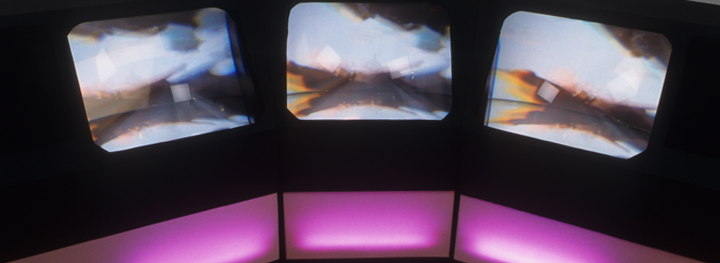Art & Art History
EVE4

Gallery 400
400 South Peoria Street, Chicago, IL 60607
(Art)n Artist Collaborations, Tom Coffin, John Edel, EVL artists, Robert Grzeszczuk, Milana Huang, Satoshi Koreki, Deb Lowman, Thomas Nawara, Kathryn T. O ’Keefe, Dave Pape, So Yon Park, Dana Plepys, Joe Reitzer, Anna Seeto, and Jonas Talandis, Maria Roussos, Trina Roy, Dan Sandin, Dave Swoboda, Marcus Thiebaux, Christina A. Vasilakis, Alan Verlo, Margaret Watson, and Ryan Christopher White
Curated by Christina Vasilakis and Tom Coffin, EVE4 is a group exhibition of virtual reality and interactive computer and electronic art created by the UIC Electronic Visualization Laboratory (EVL). The exhibition at Gallery 400, which includes interactive installations, prints, web-based galleries, and a video theatre, is accompanied by a series of screenings in the virtual reality CAVE at a separate location.
EVL advances research in computer graphics and interactive techniques through its unique interdisciplinary blend of engineering, science, and art. Its students receive MS, MFA, and PhD degrees through the UIC Electrical Engineering and Computer Science department and the UIC School of Art and Design. EVL ’s research emphasis is virtual reality; however, faculty and students are also involved in a number of related problems: multimedia; scientific visualization; new methodologies for informal science and engineering education; paradigms for information display; algorithm optimization for parallel computing; sonification; and abstract mathematical visualization.
EVL has a history of innovative contributions to the computer graphics field since its inception in 1973, as exemplified in its introduction of the CAVE virtual reality theatre in 1992. In the mid ’70s, EVL created Electronic Visualization Events (EVE), a series of public performances where images were computer generated and color processed in real time with musical accompaniment. Around the same time, EVL hardware and software were used to create the computer animation for the first Star Wars movie. In 1976, based on an idea by colleague Rich Sayre, EVL developed an inexpensive, lightweight glove to monitor hand movements; the Sayre Glove provided an effective method for multidimensional control, such as mimicking a set of sliders. Projects in the 1970s through mid-1980s center on videogame technology, real-time animation on microcomputers, and interactive multimedia installations.
In the late ’80s, the Lab began focusing on scientific visualization, developing and providing tools and techniques for research scientists and engineers. Continuing these efforts, EVL is now applying virtual environments to scientific computing. EVL promotes the use of these advanced technologies to academic, industrial, and government audiences, to make people aware that technology is key to America’s leadership role, through installations at museums and professional conferences. In recent years, EVL has received major funding for its collaboration and outreach activities from NSF, ARPA, and the U.S. Department of Energy. Throughout its history, EVL has been, and continues to be, a major influence on the advancement of electronic art and entertainment; EVL alumni and artists are internationally recognized for interactive art installations, performance art pieces, and entertainment productions.
CURATORS BIOGRAPHIES
 Tom Coffin is a media artist, technology researcher, and curator born in Lawrence, Kansas, in 1955. His work has been shown in solo exhibitions including Centerfocus and BIG ART (Venable Arts Center, 1992) and in group exhibitions such as FAXART (Gallery 400, 1990), SOLDLIKEMEAT (Atelier Sub Rosa, Chicago, 1994), and ChainReaction (Los Angeles Convention Center, 1995). Coffin studied at the Pennsylvania Academy of Fine Arts (Certificate, 1983) and the School of the Art Institute of Chicago (BFA, 1989). He is currently pursuing an MFA at the Electronic Visualization Lab at the University of Illinois Chicago.
Tom Coffin is a media artist, technology researcher, and curator born in Lawrence, Kansas, in 1955. His work has been shown in solo exhibitions including Centerfocus and BIG ART (Venable Arts Center, 1992) and in group exhibitions such as FAXART (Gallery 400, 1990), SOLDLIKEMEAT (Atelier Sub Rosa, Chicago, 1994), and ChainReaction (Los Angeles Convention Center, 1995). Coffin studied at the Pennsylvania Academy of Fine Arts (Certificate, 1983) and the School of the Art Institute of Chicago (BFA, 1989). He is currently pursuing an MFA at the Electronic Visualization Lab at the University of Illinois Chicago.
 Christina Vasilakis works between art and virtual reality as a student of the Electronic Visualization Laboratory at the University of Illinois Chicago. Vasilakis’s MFA work included chairing the planning committee for the EVE4 collaborative art event and organizing the presentation of interactive projects by MFA students in the CAVE virtual reality environment.
Christina Vasilakis works between art and virtual reality as a student of the Electronic Visualization Laboratory at the University of Illinois Chicago. Vasilakis’s MFA work included chairing the planning committee for the EVE4 collaborative art event and organizing the presentation of interactive projects by MFA students in the CAVE virtual reality environment.